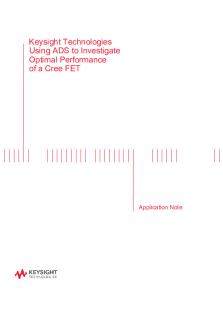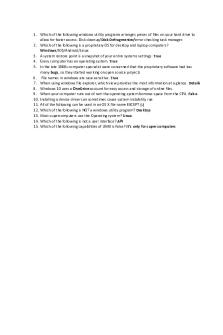UNIT 3 Design for Fluctuating Load PDF

| Title | UNIT 3 Design for Fluctuating Load |
|---|---|
| Author | Aniket Bandichhode |
| Course | B.e. (mechanical) |
| Institution | Savitribai Phule Pune University |
| Pages | 5 |
| File Size | 96.2 KB |
| File Type | |
| Total Downloads | 9 |
| Total Views | 139 |
Summary
Download UNIT 3 Design for Fluctuating Load PDF
Description
25
5 DESIGN AGAINST FLUCTUATING LOAD
5.1 Stress concentration factor is defined as (a) ratio of highest stress near the discontinuity to endurance limit (b) ratio of highest stress near the discontinuity to yield strength (c) ratio of highest stress near the discontinuity to nominal stress obtained by elementary equation (d) ratio of endurance limit to highest stress near the discontinuity 5.2 Stress concentration occurs due to (a) abrupt change in cross-section (b) discontinuities in component (c) internal cracks and flaws (d) any one of the above 5.3 Stress concentration occurs due to (a) blow holes
(b) keyways and splines
(c) machining scratches
(d) any one of the above
5.4 Stress concentration occurs at the contact between (a) meshing teeth of driving and driven gears (b) cam and follower (c) balls and races in ball bearing (d) any one of the above 5.5 In static loading, the effect of stress concentration is more serious in case of (a) components made of brittle materials (b) components made of ductile materials (c) components made of brittle as well as ductile materials (d) none of the above
26
5.6 In cyclic loading, the effect of stress concentration is more serious in case of (a) components made of brittle materials (b) components made of ductile materials (c) components made of brittle as well as ductile materials (d) none of the above 5.7 The maximum stress concentration factor for a rectangular plate with a transverse hole loaded in tension or compression is (a) 2
(b) 3
(c) 2.5
(d) 1
5.8 A stress that varies in sinusoidal manner with respect to time from a minimum value to maximum value and which has some mean as well as amplitude value is called (a) reversed stress
(b) fluctuating stress
(c) repeated stress
(d) varying stress
5.9 A stress that varies in sinusoidal manner with respect to time from zero to maximum value and which has same values for mean as well as amplitude is called
5.10
(a) reversed stress
(b) fluctuating stress
(c) repeated stress
(d) varying stress
A stress that varies in sinusoidal manner with respect to time from tensile to
compressive (or vice versa) and which zero mean is called
5.11
(a) reversed stress
(b) fluctuating stress
(c) repeated stress
(d) varying stress
Fatigue failure results due to fluctuating stresses when the stress magnitude
is (a) more than ultimate tensile strength (b) more than yield strength but lower than ultimate tensile strength (c) lower than yield strength (d) none of the above
27
5.12
5.13
The criterion of failure for machine parts subjected to fluctuating stresses is (a) ultimate tensile strength
(b) yield strength
(c) endurance limit
(d) modulus of elasticity
The factor of safety for machine parts subjected to reversed stresses is (a) ratio of yield strength to maximum stress (b) ratio of endurance limit to amplitude stress (c) ratio of ultimate tensile strength to maximum stress (d) ratio of endurance limit to mean stress
5.14
The approximate relationship between endurance limit of rotating beam
specimen ( S'e ) and ultimate tensile strength ( Sut ), in case of steel component, is
5.15
(a) S 'e = 0.4 S ut
(b) S 'e = 0.75 Sut
(c) S 'e = 0.577 Sut
(d) S 'e = 0.5 S ut
The approximate relationship between endurance limit of rotating beam
specimen ( Se' ) and ultimate tensile strength ( Sut ), in case of cast iron and cast steel components, is
5.16
(a) S 'e = 0.4 S ut
(b) S 'e = 0.75 Sut
(c) S 'e = 0.577 Sut
(d) S 'e = 0.5 S ut
The relationship between endurance limit of component subjected to
fluctuating torsional shear stresses ( Sse ) to endurance limit in revered bending ( Se ) is (a) Sse = 0.4 S e
(b) Sse = 0.75 S e
(c) Sse = 0.577 S e
(d) Sse = π S e
28
5.17
As the size of the component increases, the endurance limit of the
component (a) increases (b) decreases (c) remains same (d) increases up to the diameter of 50 mm and then decreases 5.18
The surface finish factor for a highly polished component is (a) 0.89
5.19
(b) 1
(d) 0.75
The reliability factor for using 50% reliability in design is (a) 0.897 (b) 1
5.20
(c) 0.85
(c) 0.868
(d) 0.814
The endurance limit of the component can be increased by (a) increasing the size of component (b) shot peening (c) increasing the stress concentration (d) coating
5.21
Cold working (a) increases fatigue strength (b) decreases fatigue strength (c) has no influence on fatigue strength (d) none of the above
5.22
In order to find the endurance limit, the rotating beam specimen is
subjected to (a) repeated stresses
(b) reversed stresses
(c) fluctuating stresses
(d) maximum stress
29
5.23
The notch sensitivity factor (q) is given by (a) q =
Kf Kt
−1 −1
(b) q =
Kt Kf
−1 −1
(c) q =
Kf Kt
+1 +1
(d) q =
Kt Kf
+1 +1
where Kt and Kf are theoretical and fatigue stress concentration factors respectively. Answers: 5.1 (c)
5.2 (d)
5.3 (d)
5.4 (d)
5.5 (a)
5.6 (b)
5.7 (b)
5.8 (b)
5.9 (c)
5.10 (a)
5.11 (c)
5.12 (c)
5.13 (b)
5.14 (d)
5.15 (a)
5.16 (c)
5.17(b)
5.18 (b)
5.19 (b)
5.20 (b)
5.21 (a)
5.22 (b)
5.23 (a)...
Similar Free PDFs

DESIGN AGAINST FATIGUE LOAD
- 20 Pages

Compiler Design-Unit-3-Final
- 95 Pages

Unit 3 - A worksheet for unit 3
- 3 Pages

CIVE1151 Lect 3 eqivalent load
- 17 Pages

UNIT 3 - English FOR Tourism
- 18 Pages

Unit 3- English for Tourism
- 32 Pages

Load pull for CREE device using ADS
- 22 Pages

Unit 3 homework - unit 3
- 4 Pages

QA Unit 1 Compiler Design
- 4 Pages

Unit 5 - Compiler Design - www
- 15 Pages
Popular Institutions
- Tinajero National High School - Annex
- Politeknik Caltex Riau
- Yokohama City University
- SGT University
- University of Al-Qadisiyah
- Divine Word College of Vigan
- Techniek College Rotterdam
- Universidade de Santiago
- Universiti Teknologi MARA Cawangan Johor Kampus Pasir Gudang
- Poltekkes Kemenkes Yogyakarta
- Baguio City National High School
- Colegio san marcos
- preparatoria uno
- Centro de Bachillerato Tecnológico Industrial y de Servicios No. 107
- Dalian Maritime University
- Quang Trung Secondary School
- Colegio Tecnológico en Informática
- Corporación Regional de Educación Superior
- Grupo CEDVA
- Dar Al Uloom University
- Centro de Estudios Preuniversitarios de la Universidad Nacional de Ingeniería
- 上智大学
- Aakash International School, Nuna Majara
- San Felipe Neri Catholic School
- Kang Chiao International School - New Taipei City
- Misamis Occidental National High School
- Institución Educativa Escuela Normal Juan Ladrilleros
- Kolehiyo ng Pantukan
- Batanes State College
- Instituto Continental
- Sekolah Menengah Kejuruan Kesehatan Kaltara (Tarakan)
- Colegio de La Inmaculada Concepcion - Cebu





